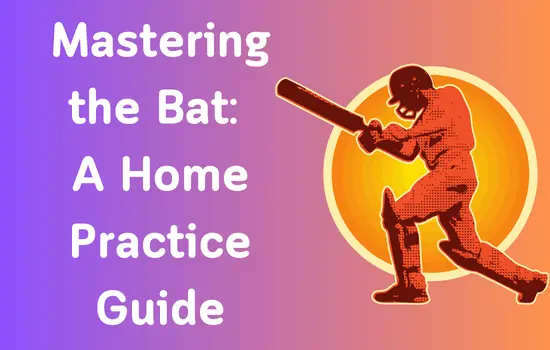Cricket batting requires a combination of technique, hand-eye coordination, and mental focus. While nets and bowling machines offer ideal practice environments, honing your skills at home is a fantastic way to stay sharp. This guide will equip cricketers of all levels, from seasoned pros to enthusiastic beginners, with effective home practice drills. So, let’s start this guide in which we are going to discuss how you can practice for batting at home.

Pro Batters: Refining Technique and Power
Shadow Batting: Refine your stroke mechanics by performing shadow batting in front of a mirror. Focus on a smooth weight transfer, proper grip, and head position. Visualize the bowler’s delivery and practice playing different shots with precise footwork.
Medicine Ball Drills: Enhance your bat speed and power with medicine ball exercises. Perform chest throws, overhead slams, and side throws, focusing on explosiveness and proper form.
Visualization: Visualize yourself succeeding in a match situation. Imagine facing specific bowlers and playing particular deliveries. This mental rehearsal can significantly improve your focus and confidence at the crease.
Video Analysis: Record yourself practicing and analyze the footage later. Look for any technical flaws in your stance, swing, or footwork. This self-assessment allows you to identify areas for improvement and make targeted corrections.
Weighted Bat Drills: Use a heavier bat for shadow batting or controlled hitting against a wall. This helps build strength and muscle memory for powerful strokes. Remember to prioritize proper technique over brute force.
Intermediate Batters: Building a Strong Foundation
Footwork Drills: Footwork is the cornerstone of good batting. Practice shuffling sideways, lunging forward and backward, and stepping across the wicket. These drills will improve your balance, agility, and ability to reach deliveries outside your off-stump.
Tennis Ball Practice: Use a tennis ball to practice hitting against a wall or bouncing off the floor. Focus on playing various strokes like drives, cuts, and pulls. This helps develop hand-eye coordination and timing.
Mirror Work: Stand in front of a mirror and practice your grip, stance, and backswing. Ensure your grip is comfortable and allows for good bat control. Your stance should be balanced and your backswing should be smooth and controlled.
Net Practice (Optional): If you have access to a net, utilize it for targeted practice. Ask a friend to bowl or use a bowling machine to simulate match conditions. Focus on playing specific deliveries and building innings.
Beginner Batters: Developing the Fundamentals
Grip Practice: Start by mastering a comfortable and secure grip. Hold the bat with your dominant hand below the handle and your other hand slightly above. Experiment until you find a grip that allows for good bat control and power.
Stance and Posture: Stand with your feet shoulder-width apart and your weight evenly distributed. Keep your head still and eyes focused on the ball. Practice maintaining a balanced and relaxed stance.
Swing Practice: With a tennis ball or soft rubber ball, practice swinging the bat without hitting anything. Focus on a smooth swing with good follow-through. Gradually increase the swing speed as you gain confidence.
Wall Drills: Use a spongy wall to practice basic strokes like defensive blocks and gentle taps. Focus on making clean contact with the ball and controlling the direction of your shots.
Balloon Batting: Blowing up balloons and hitting them with a light bat is a fun and engaging way for beginners to develop hand-eye coordination and basic batting mechanics.
Conclusion
Consistent home practice can significantly improve your batting skills. Remember to start slow, prioritize proper technique, and gradually increase the difficulty of your drills. Enjoy the process, stay focused, and watch your batting prowess go from strength to strength!

Hello, I’m Kapil Kumar, a seasoned SEO expert and blogger at WinnersList.in. My mission is to spotlight exceptional individuals and organizations across various domains. Through curated lists, profiles, and inspiring stories, I aim to celebrate outstanding achievements and inspire the next generation of champions. Join me in this journey.
